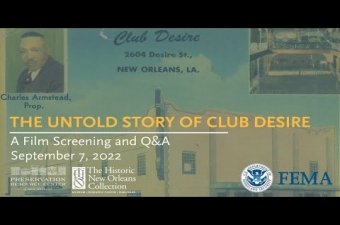Club Desire, a legendary rhythm and blues and jazz nightclub that helped launch Fats Domino, was the brainchild of Charlie Armstead, a bulky Upper Ninth Ward businessman. A bootlegger during Prohibition, Armstead later ran a restaurant and bar and in 1948 realized his dream of opening a grand nightclub at the corner of Desire and Law streets, with a big vertical neon sign reading “Club Desire” lighting up the intersection.
Opening night was on Fat Tuesday, featuring Dave Bartholomew and his stellar orchestra. Men and women arrived at “New Orleans’ Most Modern Nightclub” in their Sunday finest and were tended to by bodyguards. Inside, lights played off of glass brick walls. From a second-story balcony, diners ate fine New Orleans cuisine and looked down on the stage and the huge dance floor.
At a time when Black artists were not on radio or TV, Armstead sent music trucks around the city to advertise the club; on the night of a show, giant Klieg spotlights at the venue waved beams high into the sky. On weekends there was a floorshow with acrobats, dancers, comedians, and a posh master of ceremonies who joked, sang, and announced the acts. Every band that took the stage had to play its theme song, the ballad “That’s My Desire.”
When Armstead opened his club, the Ninth Ward was working-class, with many poor residents, both Black and white; until the 1950s it was partly rural, with many dirt roads. At least briefly, he helped change the area’s image, hosting famed Black entertainers like balladeer Billy Eckstine, Lincoln “Stepin Fetchit” Perry, Memphis Slim, and Count Basie.
But Armstead really made musical history with Fats Domino. When Domino was still unknown, he came to one of Bartholomew’s appearances dressed in overalls from his day job as a mechanic. Bartholomew’s drummer Earl Palmer, whose “backbeat” would enshrine him in the Rock and Roll Hall of Fame, knew Domino and told him to sit in when the band took a break. Domino tore up the piano (and the crowd) with the rapid fire “Swanee River Boogie,” but Bartholomew, a demanding bandleader and purposefully sharp dresser, wasn’t impressed.
In late 1948 and early 1949 Domino played Club Desire in a band led by bassist Billy Diamond (who’d recently given him the nickname “Fats” at the Robin Hood). They drew a crowd, so the small Hideaway Club, two blocks up Desire Street, hired Domino away. Bartholomew, now a champion of Domino, brought record man Lew Chudd to see him there, then went into J&M Studio to collaborate with the young pianist on “The Fat Man,” considered by some the first rock ‘n’ roll record.
Despite having a national hit, in June 1950 Domino still didn’t own a car, and Armstead bribed him to come back to Club Desire with a gray 1942 Buick. Domino played there until October, when he scored his second big hit, “Every Night about This Time,” and left for a Midwest tour. He and Bartholomew went on to become rock ‘n’ roll’s first great team, spending 13 years near the top of the R&B and pop charts.
Domino wasn’t the only up-and-coming pianist to grace the stage at Club Desire. In 1951 and 1952, the great blues guitarist Lowell Fulson performed with Ray Charles before he was known as the “genius.” It was the start of Charles’ relationship to New Orleans—he’d spend the better part of 1953 based in the city, at Foster’s Hotel.
Armstead’s health and finances declined around that time, and he died in 1954. His wife Audrey took the reins and kept the club going for “many years,” according to her granddaughter Dana Buefort. The neighborhood transformed in this period, with the sprawling Desire public housing development opening across the street in 1956. By the 70s the building was under new ownership, and Club Desire turned into a disco.
The building was vacant in 2005 when Hurricane Katrina hit and breaches in the nearby levees sent water rushing inside. Walking into the dark, deserted confines after the flood, Rick Coleman, author of Blue Monday: Fats Domino and the Lost Dawn of Rock ‘n’ Roll, reported that the dance floor, balcony, and ceiling had fallen into decay, but its glass bricks still shone bright and its ornate old bar was crowned by a giant sign: CLUB DESIRE–THE DOWNTOWN CLUB WITH UPTOWN IDEAS.
Coleman contributed to the effort to save Club Desire led by Marguerite Doyle Johnston, who lived next door to the beloved landmark. With $90,000 in back taxes attached to the property, it’d been adjudicated to the city in the early 90s. Despite the pleadings of preservationists, with no benefactor to finance repairs the city demolished it in 2016.
For more on the roots of rock ‘n’ roll in New Orleans, click here.
Videos

A 2022 panel discussion and half-hour documentary about the history of Club Desire presented by the Historic New Orleans Collection and the Preservation Resource Center.
Video posted by The Historic New Orleans Collection.
A 2022 panel discussion and half-hour documentary about the history of Club Desire presented by the Historic New Orleans Collection and the Preservation Resource Center.

A 2008 report about the effort to restore Club Desire led by Marguerite Doyle Johnston.
Video posted by WDSU News.
A 2008 report about the effort to restore Club Desire led by Marguerite Doyle Johnston.

A presentation about the historical significance of Club Desire by FEMA, which studied the building before sanctioning its demolition.
Video posted by ncppt.
A presentation about the historical significance of Club Desire by FEMA, which studied the building before sanctioning its demolition.
Images












